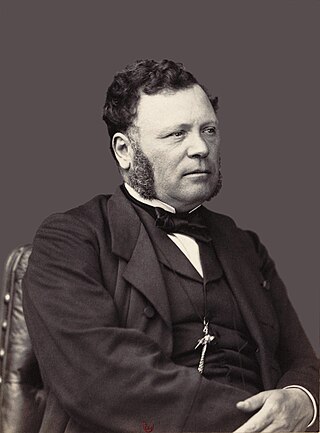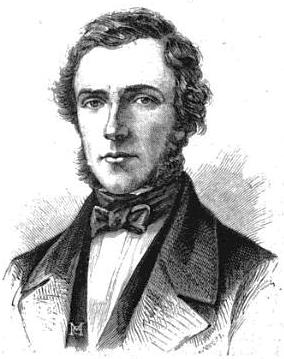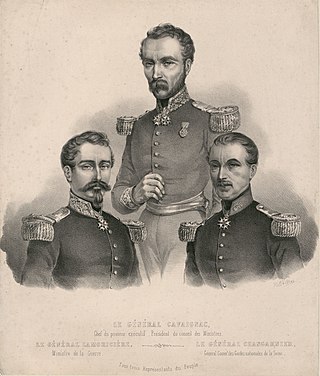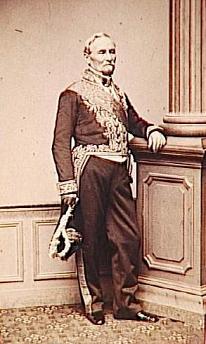
The Hôtel des Invalides, commonly called Les Invalides, is a complex of buildings in the 7th arrondissement of Paris, France, containing museums and monuments, all relating to the military history of France, as well as a hospital and a retirement home for war veterans, the building's original purpose. The buildings house the Musée de l'Armée, the military museum of the Army of France, the Musée des Plans-Reliefs, and the Musée d'Histoire Contemporaine. The complex also includes the former hospital chapel, now national cathedral of the French military, and the adjacent former Royal Chapel known as the Dôme des Invalides, the tallest church building in Paris at a height of 107 meters. The latter has been converted into a shrine of some of France's leading military figures, most notably the tomb of Napoleon.

Camille Hyacinthe Odilon Barrot was a French politician who was briefly head of the council of ministers under President Louis-Napoléon Bonaparte in 1848–49.

Eugène Rouher was a French statesman of the Second Empire.

The French Second Republic, officially the French Republic, was the republican government of France that existed between 1848 and 1852. It was established in February 1848, with the February Revolution that overthrew the July Monarchy of King Louis-Phillipe, and ended in December 1852. Following the election of President Louis-Napoléon Bonaparte in 1848 and the 1851 coup d'état the president staged, Bonaparte proclaimed himself Emperor Napoleon III and initiated the Second French Empire. The short-lived republic officially adopted the motto of the First Republic; Liberté, Égalité, Fraternité.
The Minister of Commerce was a cabinet member in the Government of France. The position sometimes included responsibility for other government departments such as Public Works, Interior, Agriculture and Posts, Telegraphs and Telephones. The position has largely been merged today into the expanded Ministry of the Economy, Finance and Industry.

The Coup d'état of 2 December 1851 was a self-coup staged by Louis-Napoléon Bonaparte, at the time President of France under the Second Republic. Code-named Operation Rubicon and timed to coincide with the anniversary of Napoleon I's coronation and victory at Austerlitz, the coup dissolved the National Assembly, granted dictatorial powers to the president and preceded the establishment of the Second French Empire a year later.

Alphonse Henri, comte d'Hautpoul was Prime Minister of France from 31 October 1849 to 10 April 1851 during the French Second Republic.

Ferdinand Victorin Barrot was a French Bonapartist politician who carried the portfolio of Interior Minister of France, 31 October 1849 to 15 March 1850.

Jean-Joseph Ange d'Hautpoul was a French cavalry general of the Napoleonic wars. He came from an old noble family of France whose military tradition extended for several centuries.

Olivier Émile Ollivier was a French statesman. Starting as an avid republican opposed to Emperor Napoleon III, he pushed the Emperor toward liberal reforms and in turn came increasingly into Napoleon's grip. He entered the cabinet and was the prime minister when Napoleon fell.
Eugène Corbin (1800–1874) was a French procureur général (prosecutor-general) and politician. During the French Second Republic (1848–1851) he helped suppress opposition to the government headed by Louis Napoleon. He was appointed Minister of Justice during the preparations for the coup of 2 December 1851, but did not accept the office and was replaced a few days later. He was first president of the Bourges court of appeal from 1852 until 1870.

The Cabinet of Léon Faucher, in which Léon Faucher was the leading minister, was formed on 10 April 1851 by President Louis-Napoleon Bonaparte. It followed the Petit ministère of 1851. The cabinet was a compromise between the Parti de l'Ordre and the Bonapartists in the period before the coup d'état of 2 December 1851. The cabinet was replaced by the Last cabinet of the French Second Republic on 26 October 1851.
The Petit ministère of 1851 governed France from 24 January 1851 to 10 April 1851 during the French Second Republic, replacing the Cabinet of Alphonse Henri d'Hautpoul. It was a compromise cabinet formed by President Louis-Napoleon Bonaparte after the National Legislative Assembly had refused to accept a cabinet dominated by Bonapartists, and had no president. It was replaced by the Cabinet of Léon Faucher on 10 April 1851. The ministers were:

The second cabinet of Odilon Barrot was the government of France from 2 June 1849 to 31 October 1849 under President of the Council Odilon Barrot. It followed the first cabinet of Odilon Barrot, dissolved before the elections to the Legislative Assembly, and was constituted by President Louis Napoleon. It was dismissed on 31 October 1849 and replaced by the cabinet of Alphonse Henri d'Hautpoul.

The first cabinet of Odilon Barrot was the government of France from 20 December 1848 to 2 June 1849 under President of the Council Odilon Barrot. It was formed after the election of Louis Napoleon as President on 20 December 1848, the day that he took his oath. It replaced the cabinet of General Cavaignac. After the May 1849 elections to the Legislative Assembly it was replaced by the second cabinet of Odilon Barrot.

The cabinet of General Cavaignac was the government of France from 28 June 1848 to 20 December 1848. It replaced the Executive Commission of 1848 after the June Days Uprising of 23 June to 26 June 1848. General Louis-Eugène Cavaignac (1802-1857) was given executive power by the National Assembly and headed the government as President of the Council of Ministers. The government was replaced by the first cabinet of Odilon Barrot on 20 December 1848 after Louis Napoleon had been elected as President.
Abuffard Eugène Augustin Woestyn was a 19th-century French playwright, librettist, poet, journalist, chansonnier and writer.
Michel Etienne Anthelme Théodore Grandperret was a French lawyer and politician. He was a staunch Bonapartist. He served briefly as Minister of Justice and Religious Affairs during the last weeks on the Second French Empire. Later he was a Life Senator from 1877 to his death.

Edme Viala Charon, Baron Charon was a French soldier who rose to the rank of Lieutenant General . He was briefly Governor General of Algeria during the French Second Republic, and was a senator of France for most of the Second French Empire.

Félix Jean-Baptiste Chadenet was a French lawyer, civil servant and politician who twice represented the department of Meuse in the legislature. He had right wing views and supported Prince Louis-Napoleon before and after the 1851 coup that established the Second French Empire.













